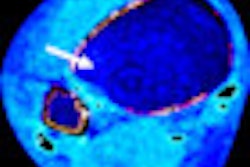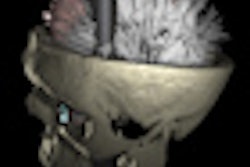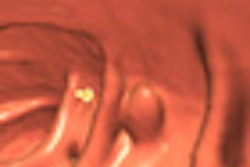A survey of patients with chronic obstructive pulmonary disease (COPD) in the Republic of Ireland suggests that better access to healthcare and more firsthand experience with CT may explain why they expressed a greater willingness to undergo low-dose CT lung cancer screening than current and former cigarette smokers in the U.S.
The survey findings, announced last week at the American Thoracic Society (ATS) annual meeting in San Francisco, offered insight into the sources of possible opposition to low-dose CT lung cancer screening among those who have the most to gain from its use, according to study author Dr. Michael Pallin of St. Vincent's University Hospital in Dublin.
A 2007 U.S. telephone survey by Dr. Gerard Silvestri of the Medical University of South Carolina found that current and former smokers were skeptical about the ability of CT lung screening to increase the probability of survival from detected lung cancer. About two of every 10 survey respondents said they would refuse CT lung screening (Thorax, February 2007, Vol. 62:2: pp. 126-130).
Coincidentally, Silvestri moderated the ATS scientific session where Pallin presented his results.
By importing Silvestri's 25-question survey to Dublin, Pallin learned current and former smokers with COPD in the city generally have positive attitudes and a fairly good general understanding of screening procedures.
COPD patients are possible candidates for CT screening because of an epidemiological link between the disease and elevated lung cancer risk. The medical literature indicates 15% to 30% of patients diagnosed with lung cancers were previously found to have COPD, Pallin said.
Pallin's survey was conducted during face-to-face interviews with 142 patients with stage II COPD at two urban Irish hospitals. Smokers ages 50 to 65 were targeted, with participants an average of 65 years old (± 6.07 years). Survey subjects had an average of 55 pack years of smoking experience.
Silvestri's findings were drawn from a national telephone survey in the U.S. involving a combination of 2,001 smokers, ex-smokers, and individuals who never habitually smoked tobacco.
Pallin found the Irish COPD patient's attitudes and opinions were significantly different than those experienced by U.S. smokers and ex-smokers (p < 0.0001 on all comparisons).
Nearly all (96.5%) of the COPD patients were willing to consider undergoing lung cancer screening. In contrast, 78.6% of U.S. smokers and ex-smokers said they were willing to receive a scan.
More than two-thirds (68%) of Irish COPD patients said they were willing to pay $250 (200 euros) to receive the procedure. Only 36.2% of their U.S. smokers and ex-smokers were amenable to self-payment.
The study revealed the Irish COPD patients had fairly good understanding about the clinical implication of low-dose CT lung screening, Pallin said. About 88% believed that early lung cancer detection results in a better chance for survival. Only 51% expressed such trust in CT lung screening in the U.S.
About 73% of the Irish COPD patients said assessing the risk for developing the disease was important when making a decision to be screened. About 93% felt that screening accuracy is an important part of that decision.
Most Irish COPD patients felt that establishing screening facilities in convenient locations was important.
Silvestri's survey established that 56% of the current smokers in the U.S. believed the risk of lung cancer and the accuracy of the screening test were important determinants in deciding whether to be screened (p < 0.05). Half of current smokers would agree to surgery for cancer diagnosed at CT screening.
Pallin focused on the issue of healthcare access and personal experience to explain why Irish COPD patients were so much more amenable to CT lung cancer screening than the U.S. smokers and ex-smokers.
Only 54% had the equivalent of a high school education, but two-thirds were covered by free state-underwritten healthcare. Most had a single, primary source of healthcare, typically a conveniently located general or family practitioner.
More than half (53.6%) had undergone a CT procedure. This included 28% who had thoracic CT in the previous year, Pallin said.
Pallin and Silvestri offered far different interpretations for the results when a pulmonologist in the audience suggested that the study indicated that the average Irish COPD patient is more intelligent than the typical American smoker.
Pallin brushed off the comment, saying the educational levels of the two groups were equivalent, and their decision-making abilities were beyond his study's scope.
Patient opinions on CT lung screening, U.S. vs. Ireland
|
|||||||||||||||
|
* Silvestri GA, et al. Thorax, February 2007, Vol. 62:2, pp. 126-130. ** Pallin MPW, et al, American Journal of Respiratory and Critical Care Medicine, May 2012, Vol. 185:1, p. A5066. |
|||||||||||||||
Silvestri, who was raised in Brooklyn, NY, before moving to South Carolina where he now conducts research, drew a distinction between education and what he called "street smarts" to explain why the Irish survey results closely reflect mainstream medical opinion about the merits of low-dose CT lung cancer screening.
"These folks have been around the medical system, as opposed to our survey, where they were just randomly called," he said. "These people have seen the medical system. They have seen the inside of a CT scanner."
According to Silvestri, American smokers in his survey were less likely than the Irish COPD patients to have a personal, ongoing relationship with a physician.
"If we are going to do screening on a big level across the United States, irrespective of COPD status, we are going to have to figure out whether these folks have medical homes," he said.




















